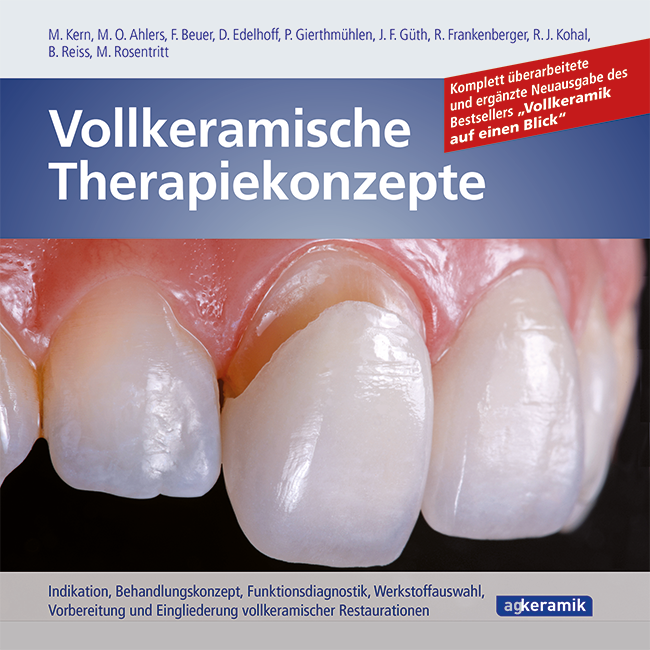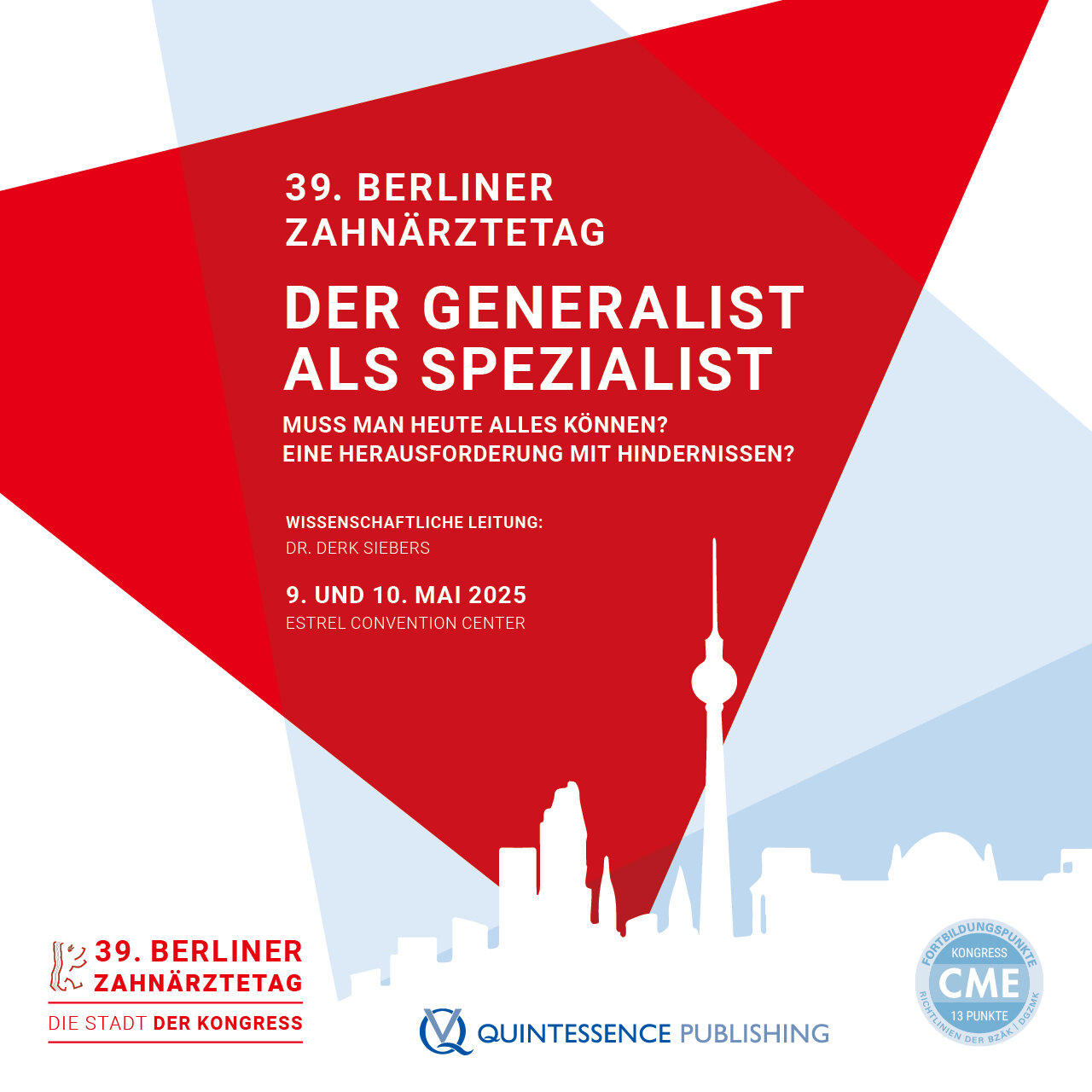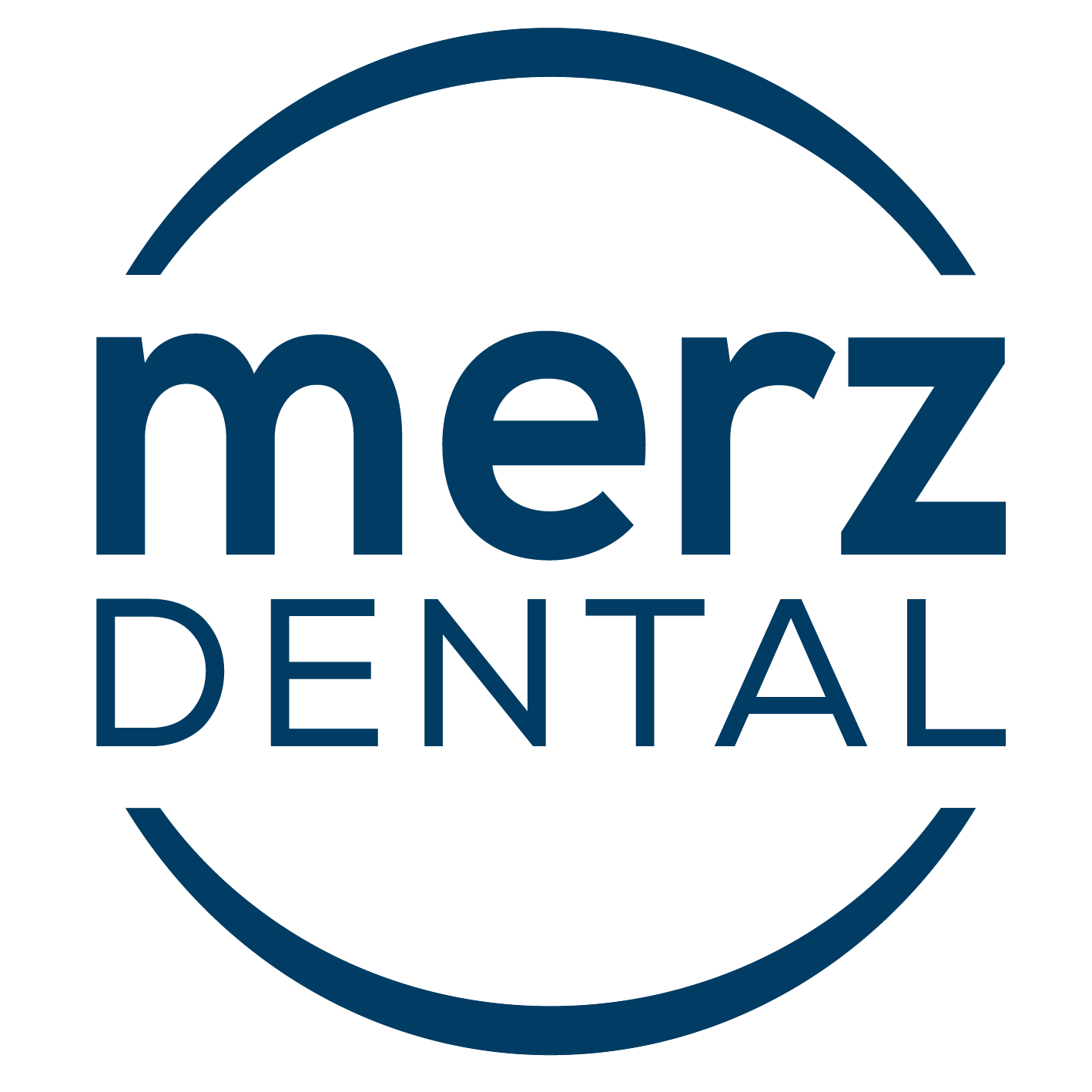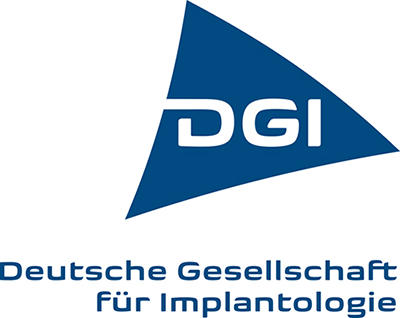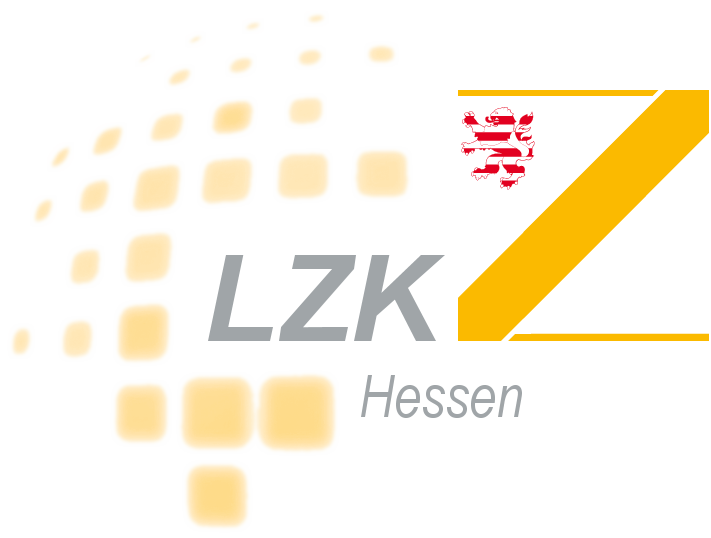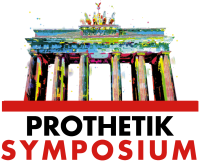The International Journal of Prosthodontics, 5/2024
Sólo en líneaDOI: 10.11607/ijp.8548, ID de PubMed (PMID): 37729488Páginas e223-e227, Idioma: InglésGraf, Tobias / Völler, Elisabeth / Schweiger, Josef / Stimmelmayr, Michael / Güth, Jan-Frederik / Erdelt, Kurt-JürgenPurpose: To evaluate the behavior of hybrid abutment crowns fabricated from monolithic lithium disilicate ceramic (LDC) and to compare the influence of different in vitro artificial aging protocols. Materials and Methods: A total of 32 monolithic hybrid abutment crowns of monolithic LDC were fabricated. Of these, 24 were artificially aged using three different protocols up to a 20 year simulation (1.2 × 106, 2.4 × 106, 4.8 × 106 chewing cycles, thermocycling), a control group underwent no artificial aging (n = 8, N = 32). Load-to-failure tests were conducted for all specimens, and failure values were compared (P < .05). Results: All specimens passed in vitro aging. Mean failure load values between 532.6 and 562.8 N were found but did neither differ significantly among the test groups nor from the control group. Conclusions: Within the limitations of this in vitro pilot study, hybrid abutment crowns manufactured from monolithic LDC seem to offer appropriate long-lasting mechanical stability over a simulation period up to 20 years. The failure values and complication pattern seem to be independent of several aging protocols in this test set-up.
Deutsche Zahnärztliche Zeitschrift, 3/2024
GesellschaftPáginas 216, Idioma: AlemánEdelhoff, Daniel / Beuer, Florian / Güth, Jan-Frederik / Schubert, Oliver / DGProNachruf der Deutschen Gesellschaft für Prothetische Zahnmedizin und Biomaterialien e. V. (DGPro)Journal of Craniomandibular Function, 2/2024
SciencePáginas 117-132, Idioma: Inglés, AlemánKordaß, Bernd / Ruge, Sebastian / Imhoff, Bruno / Güth, Jan-Frederik / Reich, Sven / Schlenz, Maximiliane A. / Hugger, Sybille / Hugger, AlfonsPosition Paper of the Study Group for Oral Physiology and Masticatory Function (DGFDT)Rapid developments in digital dentistry, such as digital workflows and CAD/CAM systems, have led to questions about digital occlusion, including the capabilities of occlusal analysis. There is a need for clear definitions and terminology. What do we mean when we talk about “occlusion” in the context of digitization, especially in the case of digital models? What are the capabilities of digital occlusal analysis? The following article presents our initial thoughts on this important topic, which may be useful in the development of future guideline.
Palabras clave: digital occlusion, digital occlusion analysis, virtual articulator, digital articulator, digital patient, digital functionally generated path technique (FGP technique)
QZ - Quintessenz Zahntechnik, 10/2024
WissenschaftPáginas 938-947, Idioma: Alemán, InglésKordaß, Bernd / Ruge, Sebastian / Imhoff, Bruno / Güth, Jan-Frederik / Reich, Sven / Schlenz, Maximiliane A. / Hugger, Sybille / Hugger, AlfonsPositionspapier des Arbeitskreises Kaufunktion und orale Physiologie der DGFDTAngesichts rasanter Entwicklungen im digitalen zahnmedizinischen Bereich (wie digitaler Workflow und CAD/CAM-Prozessabläufe) stellen sich Fragen zur digitalen Okklusion einschließlich der Möglichkeiten der okklusalen Analyse. Hierbei drängen sich Gedanken zu Definitionen und Begriffsbestimmungen auf: Was meinen wir, wenn wir im Kontext der Digitalisierung speziell bei digitalen Modellen von Okklusion sprechen und welche Potenziale ergeben sich bei einer digitalen Okklusionsanalyse? Erste Überlegungen zu diesem wichtigen Thema sollen nachfolgend vorgestellt werden, die in eine spätere Leitlinie einfließen könnten. (Der Entwurf eines Positionspapiers wurde im Rahmen der DGFDT-Jahrestagung im November 2023 in Bad Homburg vorgestellt und diskutiert. Zusätzlich wurde die vorgestellte Textfassung an weitere Expertinnen und Experten zur Kommentierung übersandt. Die Ergebnisse der Diskussion und der Kommentierung wurden in das vorliegende Positionspapier eingearbeitet.)
Palabras clave: digitale Okklusion, digitale Okklusionsanalyse, virtueller Artikulator, digitaler Patient, Digitale Functionally-Generated-Path-Technik (FGP-Technik)
Dentista, 1/2024
FokusPáginas 10-16, Idioma: AlemánHerguth, Philipp / Seidel, Kathrin / Güth, Jan-Frederik / Aini, TubaPolymer-basierte Füllungsmaterialien gelten heutzutage als Standard im Bereich der direkten plastischen Versorgung von Kavitäten. Insbesondere die Weiterentwicklung der Polymere hin zu CAD/CAM-basierten Hochleistungspolymeren in den letzten Jahren ermöglichte die Nutzung Polymer-basierter Materialien auch zur Herstellung indirekter Restaurationen. In diesem Zusammenhang entwickelten sich durch die Anwendung von Polymeren innovative Behandlungskonzepte, die mehr und mehr Einfluss auf dem Gebiet der festsitzenden zahnärztlichen Prothetik – insbesondere bei ausgedehnten Vorbehandlungen komplexer Fälle – gewannen.
QZ - Quintessenz Zahntechnik, 9/2023
InnovationPáginas 808-817, Idioma: AlemánHorn, Max / Schweiger, Josef / Schröder, Timo / Langer, Lukas / Trimpl, Johannes / Erdelt, Kurt / Schubert, Oliver / Güth, Jan-Frederik / Seidel, ChristianBeschreibung der additiven Multimaterialfertigung mithilfe von Laser-StrahlschmelzenMithilfe der additiven Multimaterialfertigung können aus verschiedenen Legierungen bestehende Teile in digitalen Prozessketten gefertigt werden. In dem Beitrag wird die Anwendbarkeit der Fertigungstechnologie für die Dentalbranche anhand zweier Applikationen gezeigt und bewertet.
Palabras clave: 3-D-Druck, additive Fertigung, Multimaterialfertigung, Doppelkronen, Implantate
International Journal of Computerized Dentistry, 4/2023
ApplicationDOI: 10.3290/j.ijcd.b3960939, ID de PubMed (PMID): 36928755Páginas 347-363, Idioma: Inglés, AlemánGoob, Janosch / Prandtner, Otto / Schweiger, Josef / Güth, Jan-Frederik / Edelhoff, DanielPronounced defects of the dental hard tissue can be caused by different etiologic factors. Most frequently, they are associated with changes in the vertical dimension of occlusion (VDO), which may also influence the condylar positions. These defects can lead to irreversible loss of tooth structure and have dramatic functional and esthetic consequences, often requiring complex rehabilitation. In this situation, CAD/CAM-fabricated occlusal splints made of tooth-colored polycarbonate are a proven and safe pretreatment approach in terms of esthetics and function. Rebuilding lost dental hard tissue to restore the occlusion and VDO to an adequate condylar position is a prerequisite for any sustainable and functional rehabilitation. In the future, digital systems will support this complex process, customizing it and making it simpler and more precise. The DMD-System (Ignident) provides patient-specific jaw movement data to optimize the CAD/CAM workflow. This system allows real movement patterns to be digitized and analyzed for functional and potential therapeutic purposes, integrating them into the dental and laboratory workflow. In the present case, the familiar tooth-colored CAD/CAM-fabricated occlusal splint is supplemented by digital centric jaw relation recording and individual movement data.
Palabras clave: vertical dimension of occlusion (VDO), instrumental functional analysis, maximum intercuspation (MI), maximal intercuspal position (MIP), centric condylar position (CCP), centric relation (CR), tooth-colored occlusal splint, digital workflow
Implantologie, 3/2023
Páginas 305-317, Idioma: AlemánHerguth, Philipp / Ruhstorfer, Miriam / Güth, Jan-Frederik / Graf, TobiasEin Update Durch die zunehmende Digitalisierung der Zahnmedizin lassen sich insbesondere implantatprothetische Therapiekonzepte vorhersehbarer gestalten und voraussagbarere Ergebnisse erzielen. Ziel ist es dabei, langfristig biologische und technische Komplikationen an den Restaurationen zu minimieren oder ganz zu vermeiden. Neben der Anwendung digitaler Planungs- und Therapieverfahren stehen bei der Versorgung mit vollkeramischen implantatgetragenen Brücken (VIB) vor allem der Befestigungsmodus sowie die Materialwahl für die Suprakonstruktion im Mittelpunkt. Bei der Wahl des Befestigungsmodus gilt es, die Vor- und Nachteile einer verschraubten vs. einer zementierten Restauration abzuwägen und eine auf die klinische Situation abgestimmte Wahl zu treffen. Darüber hinaus gibt es zurzeit jedoch noch keine klare Evidenz hinsichtlich der klinischen Langlebigkeit für oder gegen eine Befestigungsart bei vollkeramischen implantatgetragenen Brücken. Zu der Materialwahl von VIBs und deren morphologischer Gestaltung (monolithisch vs. verblendet) besteht aktuell ebenfalls noch Nachholbedarf hinsichtlich der klinischen Datenlage. Während erste Daten über 5 bis hin zu 10 Jahren für vollverblendete implantatgetragene Brücken aus Zirkoniumdioxidkeramik vorliegen, existieren bisher kaum Daten für monolithisch gestaltete implantatgetragene vollkeramische Brücken. Für implantatgetragene Brücken aus vollverblendeter Zirkoniumdioxidkeramik wurden allerdings hohe Chipping-Raten berichtet, was die Entscheidung zusätzlich erschwert. Der folgende Artikel beleuchtet die bisherigen evidenzbasierten Kenntnisse zu vollkeramischen Brücken und ordnet diese klinisch ein. Zusätzlich sollen entscheidende praxisorientierte Aspekte wie beispielsweise die Implantatplanung und Gestaltung des Emergenzprofils bei vollkeramischen Brücken mit einfließen.
Manuskripteingang: 10.07.2023, Annahme: 11.08.2023
Palabras clave: Implantate, implantatgetragener Zahnersatz, Brücken, Abutment, Keramik, Zirkoniumdioxidkeramik, Hybridabutment, Planung, Titan
The International Journal of Prosthodontics, 3/2023
DOI: 10.11607/ijp.7765, ID de PubMed (PMID): 36288491Páginas 253-261, Idioma: InglésEdelhoff, Daniel / Liebermann, Anja / Schubert, Oliver / Güth, Jan-FrederikPurpose: To analyze the clinical performance of two-wing–retained resin-bonded fixed dental prostheses (RBFDPs) after 5 years of clinical use with respect to technical and biologic complications, as well as survival and success rates.
Materials and Methods: RBFDPs were fabricated from 3Y-TZP zirconia layered by hand (Lava Frame veneered with Lava Ceram; 3M ESPE) or metal (Remanium Star, Dentaurum; layered with Reflex, Wieland). The primary endpoints were debonding and fracture. The secondary endpoints (marginal integrity, marginal discoloration, abrasion of antagonist dentition, patient satisfaction, Gingival Index, and side effects) were evaluated at baseline and after 5 years. Survival and success rates were calculated using the Kaplan- Meier method. Log-rank test was used to compare the survival and success rates of the different materials.
Results: The mean observation time was 6 years and 10 months. The estimated cumulative success rate after 5 years was 88.9% ± 10% for metal-supported and 33% ± 16% for all-ceramic two-wing RBFDPs. After conversion into one-wing RBFDPs, the survival rate was 100% in both groups. Debonding of one of the two wings was the major complication. One zirconia framework fracture occurred. Metal-based twowing RBFDPs showed a significantly higher success rate, but lower esthetic evaluation.
Conclusion: Due to a reduction in technical complication rate and less invasiveness, one-wing RBFDPs should be preferred over two-wing RBFDPs whenever possible.
International Journal of Computerized Dentistry, 2/2023
ScienceDOI: 10.3290/j.ijcd.b3762733, ID de PubMed (PMID): 36607264Páginas 149-158, Idioma: Inglés, AlemánSchubert, Oliver / Graf, Tobias / Schweiger, Josef / Güth, Jan-Frederik / Sciuk, Thomas / Erdelt, Kurt-JürgenAim: The CAM of esthetically pleasing monolithic dental restorations presents with specific challenges. One vital parameter to consider is the translucency of the materials. Previous studies have proven a correlation between translucency and material thickness for various all-ceramic materials. The aim of the present study was to assess and define the relationship between thickness and translucency in modern resin-based restorative materials.
Materials and methods: Specimens fabricated from two resin nano-ceramics (Cerasmart, Lava Ultimate), a polymer-infiltrated ceramic network (Vita Enamic), and a polymethyl methacrylate (Telio CAD) were examined, representing these different material classes. For each material, 12 specimens (n = 12) were fabricated in five thicknesses (0.4, 0.7, 1.0, 1.3, and 1.6 mm; N = 240). The translucency was measured with a spectrophotometer. The total light transmittance for each specimen was calculated applying specialized software. Regression curves were fitted to the results and their coefficient of determination (R2) fit was determined.
Results: Logarithmic regression curves showed the best R2 approximation (Cerasmart: R2 = 0.994; Vita Enamic: R2 = 0.978; Lava Ultimate: R2 = 0.997; Telio CAD: R2 = 0.997) to the light transmission values.
Conclusions: The results of the present study indicate that the translucency of resin-based materials can be calculated using a mathematic approach to estimate their optical behavior. Cerasmart, Lava Ultimate, Vita Enamic, and Telio CAD exhibit a logarithmic relationship between material thickness and translucency. By determining material-specific coefficients for this logarithmic function, the resulting translucency can be computed for any given material thickness.
Palabras clave: hybrid materials, PMMA, polymer-infiltrated ceramic network, resin nano-ceramics, translucency, translucency equation, mathematic analysis, CAD/CAM, digital workflow




